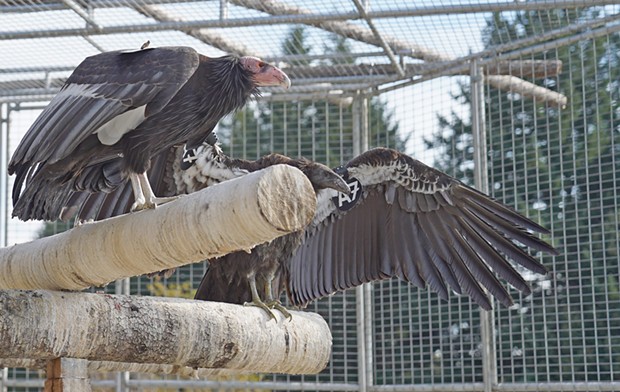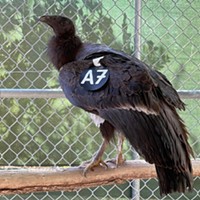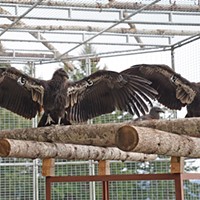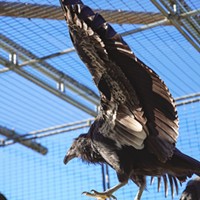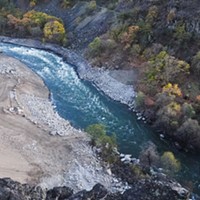Tuesday, November 8, 2022
Two More California Condors Set to Fly Free
Posted By Kimberly Wear @kimberly_wear on Tue, Nov 8, 2022 at 12:48 PM
If all goes as planned, two more California condors will be taking a first flight into the wild Wednesday, bringing to eight the number of the endangered birds now flying free over the North Coast as part of a Yurok Tribe-led effort to bring back the bird they know as prey-go-neesh to its former territory.
The birds set to try out their wings are A6 and A7, the last of the four in a second cohort of condors that arrived in mid-August. A7, a young female, recently returned from the Oakland Zoo after recovering from minor surgery by vets there to remove what appeared to be an embedded bone fragment that caused an infection in her jaw.
Those two will join four others — Ney-gem' 'Ne-chween-kah (She carries our prayers, A0), Hlow Hoo-let (Finally, I/we fly, A1), Nes-kwe-chokw' (He returns/arrives, A2) and Poy'-we-son (The one who goes ahead, “leader,” A3) — that took their historic flights in May and July, becoming the first of massive birds with a nearly 10-foot wingspan to do so locally in more than a century — as well as Cher-perhl So-nee-ne-pek' (I feel strong, A4); and Neee'n (Watcher, A5) that were released last month.
After A6 and A7 fly the coop, they, too, will receive Yurok names.
“I can’t wait to see A6 and A7 join the six condors in the wild,” said Northern California Condor Restoration Program Manager and Yurok Wildlife Department senior biologist Chris West in a news release. “Condors are an extremely social species that learn from each other. The previously released birds are adapting well to their new environment and I expect they will teach A6 and A7 how to do the same.”
The release attempt can be viewed live on the Yurok condor cam, which can be found here: https://www.yuroktribe.org/yurok-condor-live-feed.
The NCCRP, a partnership between the Yurok Tribe and Redwood National and State Parks, plans to reintroduce one cohort of prey-go-neesh every year for at least the next two decades, with the goal of spreading the species up into the Pacific Northwest.
The multi-step release process begins at dawn, when the NCCRP team will open the door to a baited enclosure, or trap, which is adjacent to the main pen. According to the release, that door stays open until one or both A6 and A7 enter.
Another component includes waiting for the now free-flying prey-go-neesh to be in the area of the release and management enclosure to help smooth the transition into the wild for the younger birds by acting as a “signal to the captive condors that it is safe to exit the flight pen.”
Once that happens, if A6 or A7 or both are in the trap area, the door back to the main enclosure is closed and another gate is opened, which allows the birds access to the outside, if they choose to go.
The staggered release method follows the same one used with the first cohort and the first two birds of the second cohort, which allows the NCCRP team to monitor how the condors are adjusting to their new surroundings while also helping to keep those flying free coming back, with the birds in the enclosure providing a “social draw.”
The NCCRP reports good news on that front, with the prey-go-neesh on the outside beginning to explore more and more of the redwood region.
“Within the last month, the birds greatly expanded their range from a fairly confined area within a few miles of the release site to more 30 miles away. The young condors have spent time near Horse Mountain in Six Rivers National Forest and soared above Big Lagoon and Stone Lagoon on the coast. They have also taken several trips to Bureau of Land Management property in Lacks Creek, which is approximately 20 miles northeast of Eureka.
Read the Northern California Condor Restoration Program release below:
The birds set to try out their wings are A6 and A7, the last of the four in a second cohort of condors that arrived in mid-August. A7, a young female, recently returned from the Oakland Zoo after recovering from minor surgery by vets there to remove what appeared to be an embedded bone fragment that caused an infection in her jaw.
Those two will join four others — Ney-gem' 'Ne-chween-kah (She carries our prayers, A0), Hlow Hoo-let (Finally, I/we fly, A1), Nes-kwe-chokw' (He returns/arrives, A2) and Poy'-we-son (The one who goes ahead, “leader,” A3) — that took their historic flights in May and July, becoming the first of massive birds with a nearly 10-foot wingspan to do so locally in more than a century — as well as Cher-perhl So-nee-ne-pek' (I feel strong, A4); and Neee'n (Watcher, A5) that were released last month.
After A6 and A7 fly the coop, they, too, will receive Yurok names.
“I can’t wait to see A6 and A7 join the six condors in the wild,” said Northern California Condor Restoration Program Manager and Yurok Wildlife Department senior biologist Chris West in a news release. “Condors are an extremely social species that learn from each other. The previously released birds are adapting well to their new environment and I expect they will teach A6 and A7 how to do the same.”
The release attempt can be viewed live on the Yurok condor cam, which can be found here: https://www.yuroktribe.org/yurok-condor-live-feed.
The NCCRP, a partnership between the Yurok Tribe and Redwood National and State Parks, plans to reintroduce one cohort of prey-go-neesh every year for at least the next two decades, with the goal of spreading the species up into the Pacific Northwest.
The multi-step release process begins at dawn, when the NCCRP team will open the door to a baited enclosure, or trap, which is adjacent to the main pen. According to the release, that door stays open until one or both A6 and A7 enter.
Another component includes waiting for the now free-flying prey-go-neesh to be in the area of the release and management enclosure to help smooth the transition into the wild for the younger birds by acting as a “signal to the captive condors that it is safe to exit the flight pen.”
Once that happens, if A6 or A7 or both are in the trap area, the door back to the main enclosure is closed and another gate is opened, which allows the birds access to the outside, if they choose to go.
The staggered release method follows the same one used with the first cohort and the first two birds of the second cohort, which allows the NCCRP team to monitor how the condors are adjusting to their new surroundings while also helping to keep those flying free coming back, with the birds in the enclosure providing a “social draw.”
The NCCRP reports good news on that front, with the prey-go-neesh on the outside beginning to explore more and more of the redwood region.
“Within the last month, the birds greatly expanded their range from a fairly confined area within a few miles of the release site to more 30 miles away. The young condors have spent time near Horse Mountain in Six Rivers National Forest and soared above Big Lagoon and Stone Lagoon on the coast. They have also taken several trips to Bureau of Land Management property in Lacks Creek, which is approximately 20 miles northeast of Eureka.
Read more about the condor restoration program in the Journal's June 23 cover story here and on the Yurok Tribe website here. (Just a note, when the story went to print A0 had been on a long sojourn but she later returned to the management and release site.)
Read the Northern California Condor Restoration Program release below:
At 7:30 a.m. on Wednesday, November 9, the Northern California Condor Restoration Program (NCCRP) plans to release two more prey-go-neesh (California condors) into Yurok Country.
The release attempt can be viewed live on the Yurok condor cam, which can be found here: https://www.yuroktribe.org/yurok-condor-live-feed
The birds include A6 and A7. A6, a male, was born on May 22, 2021, at the Oregon Zoo's Jonsson Center for Wildlife Conservation. A7, a female was born on June 2, 2021, at the Peregrine Fund’s World Center for Birds of Prey.
“I can’t wait to see A6 and A7 join the six condors in the wild,” said NCCRP Manager and Yurok Wildlife Department Senior Biologist Chris West. “Condors are an extremely social species that learn from each other. The previously released birds are adapting well to their new environment and I expect they will teach A6 and A7 how to do the same.”
For the release, NCCRP biologists will implement a multistep procedure to ease the juvenile birds’ transition into the wild. The process will begin as dawn begins to lighten the area around the enclosure. Before full-light, NCCRP will open the door to a baited enclosure, or trap, attached to the flight pen. This door will remain open until one or both pre-release birds enter the enclosure and when one or more of the previously released prey-go-neesh are present at the facility or near it.
The presence of free-flying birds signals to the captive condors that it is safe to exit the flight pen. Once the wild birds are present and one or more of the target birds are feeding on the bait in the trap, the door between the main flight pen and the trap will be closed.
Then, a second door will be opened and the birds will have access to the outside world. If only one condor walks into the staging area and the other stays in the flight pen for a certain period of time, NCCRP will release one bird.
Depending on the time of day, there may be an attempt to release the second bird. If an initial release does not occur, or if only one bird is released on day one, a second attempt will be made the following day. The condors must voluntarily enter and exit the staging area. The timing of the release is wholly dependent upon the birds’ actions.
Additionally, young, captive-raised prey-go-neesh are incredibly cautious. The first release unfolded in a few hours. The second and third releases took multiple days.
The six released condors are beginning to explore the redwood region. Within the last month, the birds greatly expanded their range from a fairly confined area within a few miles of the release site to more 30 miles away. The young condors have spent time near Horse Mountain in Six Rivers National Forest and soared above Big Lagoon and Stone Lagoon on the coast. They have also taken several trips to Bureau of Land Management property in Lacks Creek, which is approximately 20 miles northeast of Eureka.
On May 3, 2022, NCCRP released the first condors to fly over Yurok skies in more than a century. In the following months, the program released four more birds. Yurok Wildlife Department Director Tiana Williams-Claussen selected Yurok names for each condor, which include: A0, Ney-gem' 'Ne-chween-kah (She carries our prayers); A1, Hlow Hoo-let (Finally, I/we fly); A2, Nes-kwe-chokw' (He returns/arrives); A3, Poy'-we-son (The one who goes ahead); A4, Cher-perhl So-nee-ne-pek' (I feel strong); and A5, Neee'n (Watcher). A6 and A7 will receive Yurok names after their release.
The staggered release is one component of a comprehensive plan to ensure the success of the young birds. NCCRP, a partnership between the Yurok Tribe and Redwood National and State Parks, plans to reintroduce one cohort of prey-go-neesh every year for at least the next two decades. The tribe and park collaboratively manage the new population.
The Yurok Tribe and Prey-go-neesh
The Yurok Tribe initiated the condor reintroduction project in 2008. The restoration of this sacred species is an important component of the Tribe’s environmental and cultural restoration work. In addition to the reintroduction of the critically endangered condor, the Tribe is currently restoring fish and wildlife habitat on a large-scale in the Klamath River and Sacramento basins.
The Tribe is also intimately involved in the pending removal of four Klamath River dams, which represents the largest river restoration project in US history. The removal of the dams will benefit a wide diversity of fish and wildlife species, including condors.
With funding support from the Yurok Tribe, Redwood National Park, the U.S. Fish and Wildlife Service, the Bureau of Indian Affairs, the Administration for Native Americans, as well as Pacific Gas and Electric Company, Global Conservation Fund, the Redwood National Park Foundation, and many more corporate, agency and private supporters and citizens, the Yurok Wildlife Department completed a vast volume of work to prepare for the reintroduction of this imperiled species.
Working in cooperation with the Ventana Wildlife Society, Redwood National Park, California State Parks, and Pacific Gas and Electric Company, as well as volunteers, the Tribe designed and built the NCCRP release and management facility.
The flight pen includes a simulated, shock-wired power pole (to teach the birds to avoid this threat after release), two four-foot diameter pools, and perches overlooking old-growth redwood forest. NCRRP staff monitor the birds from modified shipping containers which form a fire-resistant observation structure. The facility also allows biologists and technicians to conduct regular health assessments and provide medical treatment, if necessary.
Speaking of...
Readers also liked…
more from the author
-
Eureka Man Killed in SoHum Crash
- Jul 1, 2024
-
Caltrans Selects Tunnel Option for Last Chance Grade
- Jun 18, 2024
-
Kyle Steven Wear: 1970 —2024
- Jun 16, 2024
- More »
